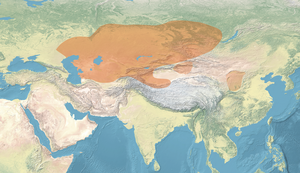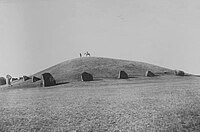Tagar culture

Location of the Tagar culture (site of Tagar) within the Saka realm ( ), and contemporary Asian polities c. -325 | |
| Geographical range | South Central Siberia |
|---|---|
| Period | Bronze Age |
| Dates | ca. 800–168 BC |
| Preceded by | Pazyryk culture, Arzhan culture, Karasuk culture |
| Followed by | Tesinsky culture, Tashtyk culture |
The Tagar culture[a] was a Bronze Age Saka archeological culture which flourished between the 8th and 1st centuries BC in South Siberia (Republic of Khakassia,[1] southern part of Krasnoyarsk Territory, eastern part of Kemerovo Province). The culture was named after an island in the Yenisei River opposite Minusinsk. The civilization was one of the largest centres of bronze-smelting in ancient Eurasia.
History
[edit]
The Tagar culture was preceded by the Karasuk culture.[2][3][4] They are usually considered as descendants of the Andronovo culture, and are frequently linked to Indo-Iranians.[5] However, the Turkic Dinlin tribe was also a part of the Tagar culture.[6] The Tagar people possessed a mixture of West and East Eurasian ancestry, with East Asian ancestry increasing in to the Iron Age.[7]
From the 2nd century BCE, the Tagar period was succeeded by a period Hunnic influence linked to the rise of the Xiongnu. The "Tesinsky culture" was a culture of the Minusinsk basin, from the 1st century BCE to the 1st century CE.[8] The Tesinsky culture was at the junction between the Tagar culture and the culture of the Xiongnu and the Xianbei, and artistic evolutions can be traced to that period.[9]
The Tashtyk culture (1st-4th century CE) then followed.[5][3][4]
Research
[edit]

The Minusinsk basin was first excavated by Daniel Gottlieb Messerschmidt in 1722. Messerschmidt and Philip Johan von Strahlenberg were the first to point out similarities between the Tagar and Scythian cultures further west. The first archaeological descriptions of the Tagar were made by Sergei Teploukhov. His periodization have formed the basis for later research.[5]
Characteristics
[edit]The Tagar lived in timber dwellings heated by clay ovens and large hearths. Some settlements were surrounded by fortifications. They made a living by raising livestock, predominantly large horned livestock and horses, goats and sheep. There are evidence of farming with evidence of irrigation.[5]
The Tagar produced animal art motifs (Scythian art) very similar to the Scythians of southern European Russia.[3][4]
Perhaps the most striking feature of the culture are huge royal kurgans fenced by stone plaques, with four vertical stelae marking the corners. Burials from the early Tagar period are characterized as single burials. In the later Tagar period, collective burials become more common. This has been interpreted as a sign of social evolution in Tagar society.[5]

Physical characteristics
[edit]The Tagar people have been the subject of numerous studies by physical anthropologists.[5] The Tagars have been described by researchers as having Europoid features.[3]
Genetics
[edit]

In 2009, a genetic study of ancient Siberian cultures, the Andronovo culture, the Karasuk culture, the Tagar culture and the Tashtyk culture, was published in Human Genetics.[3] Twelve individuals of the Tagar culture from 800 BC to 100 AD were surveyed.[3] Extractions of mtDNA from ten individuals were determined to represent three samples of haplogroup T3, one sample of I4, one sample G2a, one sample of C, one sample of F1b and three samples of H (including one sample of H5).[3] Extractions of Y-DNA from six individuals were all determined to be of Y-chromosome haplogroup R1a1, which is thought to mark the eastward migration of the early Indo-Europeans.[3] Based on an analysis of 10 SNPs, the majority of Tagar individuals were classified as being primarily of European ancestry, with the exception of one mixed ancestry individual. Of the specimens yielding a pigmentation phenotype, slightly more than half (5) were assigned blue eye color, while 4 were possibly blue or brown eyed. Most were assigned blond or light brown hair color.[3]
In 2018, a study of mtDNA from remains of the Tagar culture was published in PLOS One. Remains from the early years of the Tagar culture were found to be closely related to those of contemporary Scythians on the Pontic steppe. The authors of the study suggested that the source of this genetic similarity was a substantial increase in the frequency of East Asian maternal haplogroups in the Tagar population, which occurred during the Iron Age. Nearly 46% of Tagar samples carried an East Asian maternal haplogroup in the Iron Age, with lineages D and C more than tripling in frequency compared to the Early Tagar period.[13]
A genetic study published in Nature in May 2018 examined the remains of eight individuals ascribed to the Tagar culture. The three samples of Y-DNA collected all belonged to haplogroup R1. The samples of mtDNA collected were N1a1a1a1, N9a9, H5a1, W1c, U2e2, A8a1, U2e1h and F1b1b. The Tagar had a higher amount of Eastern Hunter-Gatherer (EHG) ancestry than all other peoples of the Scythian cultures. They were determined to be of about 83,5% Western Steppe Herder (WSH) ancestry, 9% Ancient North Eurasian (ANE) ancestry, and 7,5% Siberian Hunter-Gather ancestry.[14]
A subsequent genetic study in 2020 modeled the Tagar specimens as deriving around 70% ancestry from the Sintashta culture, 25% from Ancient Northeast Asian (ANA) Baikal hunter-gatherers, and 5% from the Bactria–Margiana Archaeological Complex.[15]
- Salbyk kurgan, the largest tumulus of the Tagar culture
- Salbyk kurgan reconstruction.[16]
- Salbyk kurgan megalith
- Evolution of bronze knives, from the Karasuk culture to the Tagar culture
- Horse accoutrement
Notes
[edit]References
[edit]| Bronze Age |
|---|
| ↑ Chalcolithic |
| ↓ Iron Age |
- ^ a b c Pilipenko, Aleksandr S. (20 September 2018). "Maternal genetic features of the Iron Age Tagar population from Southern Siberia (1st millennium BC)". PLOS ONE. 13 (9): e0204062. Bibcode:2018PLoSO..1304062P. doi:10.1371/journal.pone.0204062. ISSN 1932-6203. PMC 6147448. PMID 30235269.
- ^ Di Cosmo, Nicola (April 22, 2004). Ancient China and Its Enemies: The Rise of Nomadic Power in East Asian History. Cambridge University Press. ISBN 978-0521543828. Retrieved February 17, 2015.
- ^ a b c d e f g h i Keyser, Christine; Bouakaze, Caroline; Crubézy, Eric; Nikolaev, Valery G.; Montagnon, Daniel; Reis, Tatiana; Ludes, Bertrand (May 16, 2009). "Ancient DNA provides new insights into the history of south Siberian Kurgan people". Human Genetics. 126 (3): 395–410. doi:10.1007/s00439-009-0683-0. PMID 19449030. S2CID 21347353.
- ^ a b c "Neolithic and Metal Age cultures". Encyclopædia Britannica Online. Encyclopædia Britannica. Retrieved February 15, 2015.
- ^ a b c d e f Damgaard et al. 2018.
- ^ Hartley, Charles W.; Yazicioğlu, G. Bike; Smith, Adam T. (19 November 2012). The Archaeology of Power and Politics in Eurasia: Regimes and Revolutions. Cambridge University Press. p. 245. ISBN 978-1-139-78938-7. "The Dinlin are considered to have been part of the Tagar Culture and are mentioned in the written sources as being among the acquired "possessions" of the Huns (Mannai—Ool 1970: 107; Sulimirski 1970: 112)."
- ^ Pilipenko, Aleksandr S. (20 September 2018). "Maternal genetic features of the Iron Age Tagar population from Southern Siberia (1st millennium BC)". PLOS ONE. 13 (9): e0204062. Bibcode:2018PLoSO..1304062P. doi:10.1371/journal.pone.0204062. ISSN 1932-6203. PMC 6147448. PMID 30235269.
The Tagar population had a mixed mtDNA pool dominated by Western Eurasian haplogroups and subgroups (H, HV6, HV*, I, K, T, U2e, U4, U5a, and U*) and, to a lesser degree, Eastern Eurasian haplogroups (A*, A8, C*, C5, D, G2a, and F1b). The Tagar population showed a similar mtDNA pool structure to those of other Iron Age populations representing the "Scythian World." We observed particularly high similarity between the Tagar and Classic Scythians from the North Pontic region. Our results support the assumption that genetic components introduced by Bronze Age migrants from Western Eurasia contributed to the formation of the genetic composition of Scythian period populations in Southern Siberia.
- ^ "Hall 31. Tesinsky culture exhibit". State Hermitage Museum.
- ^ Байбердина (Талягина), М. А. (24 September 2019). "ИЗОБРАЖЕНИЯ ТЕСИНСКОГО ВРЕМЕНИ В МИНУСИНСКОЙ КОТЛОВИНЕ В КОНТЕКСТЕ АРХЕОЛОГИЧЕСКОГО МАТЕРИАЛА". Теория и практика археологических исследований (in Russian). 27 (3): 20–34. doi:10.14258/tpai(2019)3(27).-02. ISSN 2712-8202.
- ^ Yang, Jianhua; Shao, Huiqiu; Pan, Ling (2020). "The Northern Zone of China and the Eurasian Steppe in the Early Iron Age". The Metal Road of the Eastern Eurasian Steppe: The Formation of the Xiongnu Confederation and the Silk Road. Springer. p. Fig. 5.43. doi:10.1007/978-981-32-9155-3_5. ISBN 978-981-329-155-3. S2CID 213480715.
- ^ Jeong, Choongwon (2020). "A Dynamic 6,000-Year Genetic History of Eurasia's Eastern Steppe". Cell. 183 (4): 890–904.e29. doi:10.1016/j.cell.2020.10.015. hdl:21.11116/0000-0007-77BF-D. ISSN 0092-8674. PMC 7664836. PMID 33157037.
- ^ Svyatko, Svetlana V; Mallory, James P; Murphy, Eileen M; Polyakov, Andrey V; Reimer, Paula J; Schulting, Rick J (2009). "New Radiocarbon Dates and a Review of the Chronology of Prehistoric Populations from the Minusinsk Basin, Southern Siberia, Russia" (PDF). Radiocarbon. 51 (1): 243–273. doi:10.1017/S0033822200033798.
- ^ Pilipenko, Aleksandr S.; Trapezov, Rostislav O.; Cherdantsev, Stepan V.; Babenko, Vladimir N.; Nesterova, Marina S.; Pozdnyakov, Dmitri V.; Molodin, Vyacheslav I.; Polosmak, Natalia V. (20 September 2018). "Maternal genetic features of the Iron Age Tagar population from Southern Siberia (1st millennium BC)". PLOS ONE. 13 (9): e0204062. Bibcode:2018PLoSO..1304062P. doi:10.1371/journal.pone.0204062. ISSN 1932-6203. PMC 6147448. PMID 30235269. "According to the results of Unterlander et al. [4], East Eurasian mtDNA components in the Western Eurasian steppe belt increased during the Early Iron Age .... The observed reduction in the genetic distance between the Middle Tagar population and other Scythian-like populations of Southern Siberia (Fig 5; S4 Table), in our opinion, is primarily associated with an increase in the role of East Eurasian mtDNA lineages in the gene pool (up to nearly half of the gene pool) and a substantial increase in the joint frequency of haplogroups C and D (from 8.7% in the Early Tagar series to 37.5% in the Middle Tagar series)." .... "We observed differences in the mtDNA pool structure between the Early and the Middle chronological stages of the Tagar culture population, as evidenced by the change in the ratio of Western to Eastern Eurasian mtDNA components. The contribution of Eastern Eurasian lineages increased from about one-third (34.8%) in the Early Tagar group to almost one-half (45.8%) in the Middle Tagar group."
- ^ Damgaard et al. 2018, "The southern Siberian Tagar show unequal ancestry contributions from Bronze Age herders (83.5%) and southern Siberian hunter-gatherers (7.5%), as well as an additional contribution of Mal’ta (MA1 individual)-like ancestry (9%), indicating differences in the sources of hunter-gatherer admixture across the Sakas.".
- ^ Jeong, Choongwon; Wang, Ke; Wilkin, Shevan; Taylor, William Timothy Treal; Miller, Bryan K.; Bemmann, Jan H.; Stahl, Raphaela; Chiovelli, Chelsea; Knolle, Florian; Ulziibayar, Sodnom; Khatanbaatar, Dorjpurev; Erdenebaatar, Diimaajav; Erdenebat, Ulambayar; Ochir, Ayudai; Ankhsanaa, Ganbold (2020-11-12). "A Dynamic 6,000-Year Genetic History of Eurasia's Eastern Steppe". Cell. 183 (4): 890–904.e29. doi:10.1016/j.cell.2020.10.015. hdl:21.11116/0000-0007-77BF-D. ISSN 0092-8674. PMC 7664836. PMID 33157037. S2CID 214725595.
- ^ Marsadolov, L. (2014). "The Great Salbyk Barrow in Siberia (Archaeoastronomical Aspects of its Studying)". Archaeoastronomy and Ancient Technologies. 2 (2): 59–65. S2CID 132181643.
- ^ Yang, Jianhua; Shao, Huiqiu; Pan, Ling (2020). "The Northern Zone of China and the Eurasian Steppe in the Early Iron Age". The Metal Road of the Eastern Eurasian Steppe: The Formation of the Xiongnu Confederation and the Silk Road. Springer. p. Fig. 5.37. doi:10.1007/978-981-32-9155-3_5. ISBN 978-981-329-155-3. S2CID 213480715.
External links
[edit]- "Тагарская культура (Tagar culture)" (in Russian).
- The Tagar culture is presented in Hall 31 of the State Hermitage Museum (3D Tour).
Further reading
[edit]- Damgaard, P. B.; et al. (May 9, 2018). "137 ancient human genomes from across the Eurasian steppes". Nature. 557 (7705). Nature Research: 369–373. Bibcode:2018Natur.557..369D. doi:10.1038/s41586-018-0094-2. hdl:1887/3202709. PMID 29743675. S2CID 13670282. Retrieved April 11, 2020.





![Salbyk kurgan reconstruction.[16]](http://upload.wikimedia.org/wikipedia/commons/thumb/0/08/Salbyk_kurgan_reconstruction.png/200px-Salbyk_kurgan_reconstruction.png)

![Bronze weapons of the Tagar culture, Krasnojarsk, Russia, 7th-5th century BC.[17]](http://upload.wikimedia.org/wikipedia/commons/thumb/1/1c/Museum_f%C3%BCr_Vor-_und_Fr%C3%BChgeschichte_Berlin_007a.JPG/178px-Museum_f%C3%BCr_Vor-_und_Fr%C3%BChgeschichte_Berlin_007a.JPG)


